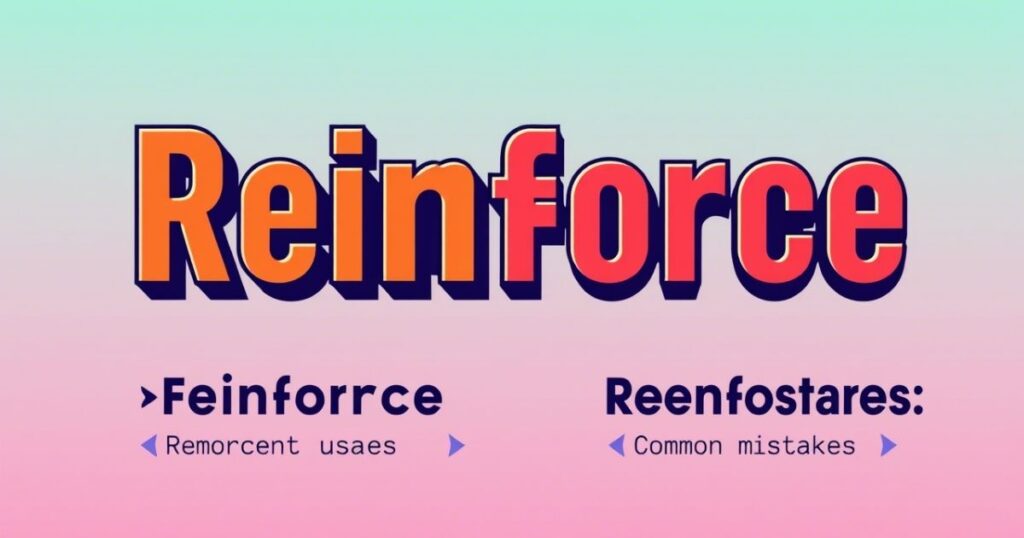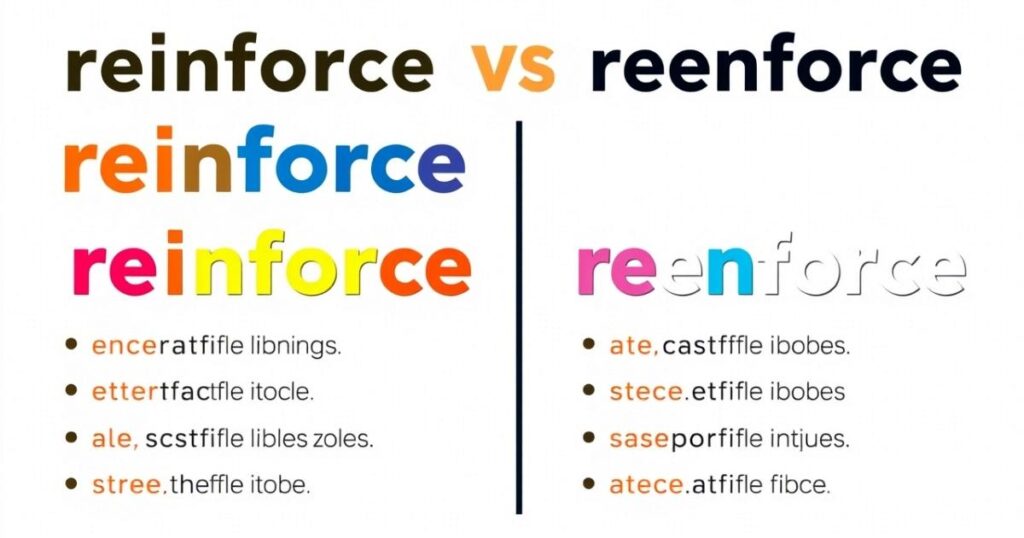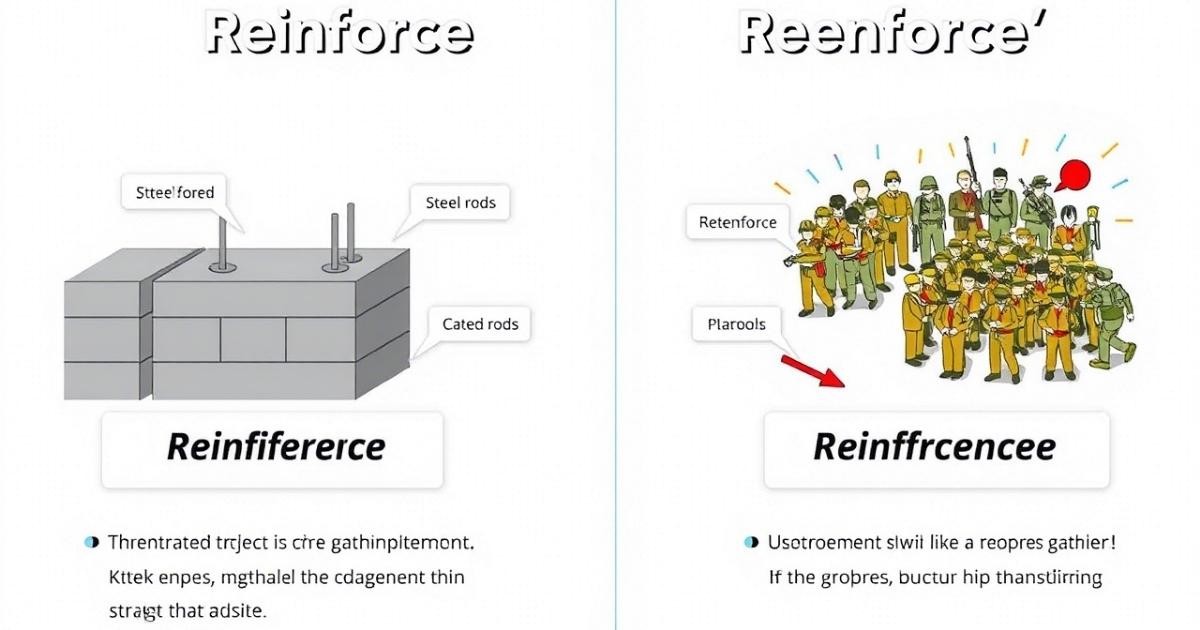When it comes to Reinforce Vs Reenforce, many people get confused about the right spelling and usage. The correct term is reinforce, which means to strengthen or provide support. On the other hand, reenforce is not a standard word and is generally considered a misspelling of reinforce. So, whenever you’re unsure whether to use reinforce or reenforce, always choose reinforce to ensure clarity in your writing.
Understanding the difference between reinforce vs reenforce is key to improving your language skills. You may also come across variations like re-enforce or reinforce or even reenforcing or reinforcing, but the main takeaway is that reinforce is the proper term. Whether you’re talking about reinforcing a building, behavior, or idea, it’s essential to use the correct spelling. So, next time you’re deciding between reinforce vs reenforce, remember to stick with reinforce!
which one is right Reinforce or Reenforce? What’s the main answer?
When deciding between reinforce and reenforce, the main answer is clear: reinforce is the correct term. Reenforce is a common misspelling and should be avoided in writing.
Reinforce refers to the act of strengthening or supporting something, such as reinforcing a structure or an idea. For example, a reinforced bridge is one that has been made stronger to support more weight.
The confusion with reenforce likely stems from the pronunciation or a typo, but the right choice is always reinforce. Using the correct spelling ensures clear and professional communication in both written and spoken contexts.
1. Spelling of Reinforce and Reenforce:

The word “reinforce” is spelled right. It’s super important to use the correct spelling so that people can understand what you’re saying and maintain clarity in writing. “Reenforce” is not the correct spelling, and using it could confuse readers or make your writing seem unprofessional.
Let’s dive into “reinforce” and “reenforce” with some examples to show how they’re used in different situations. “Reinforce” is a verb meaning to make something stronger or provide additional support, often through extra actions or measures.
In construction, workers might use steel beams to reinforce a building’s foundation. This added support helps the structure remain stable and durable over time. In schools, teachers often use rewards or praise to reinforce good behavior, encouraging students to continue making positive choices. Similarly, in sports, a coach might organize extra practice sessions to reinforce skills, improving players’ abilities and boosting their performance.
While the word “reenforce” might pop up occasionally, it’s not considered correct or widely accepted in standard English. It’s better to stick with “reinforce” if you want your writing to be accurate and consistent. In informal speech, you might hear reenforce used, but in formal writing, always choose reinforce for clarity and professionalism.
To summarize, “reinforce” is the correct term to use when you want to strengthen something, whether it’s a structure, behavior, or idea. Use examples like those above to demonstrate its proper usage, and remember that “reenforce” is not a standard spelling.
- Definition of reinforce: To strengthen or provide additional support.
Example: “The teacher used extra worksheets to reinforce the lesson.”
- Definition of reenforce: Often mistakenly used as a synonym for reinforce but is not a standard term.
Example: “They decided to reenforce their commitment to community service.” (Correct term: reinforce)
- Usage of reinforce: Commonly used in both everyday and professional settings.
Example: “The construction workers will reinforce the building’s foundation.”
- Usage of reenforce: Rarely used and typically considered incorrect in standard English.
Example: “We need to reenforce our safety measures.” (Correct term: reinforce)
- Context of reinforce: Frequently used in education, psychology, engineering, and policy discussions.
Example: “Positive feedback can reinforce desired behaviors in students.”
- Context of reenforce: Seen mostly in informal or non-standard contexts, but should be replaced with reinforce in formal writing.
Example: “The committee will reenforce the proposal’s importance.” (Correct term: reinforce)
- Education: Teachers use reinforce to describe efforts that strengthen a student’s understanding or behavior. Positive reinforcement helps in learning by encouraging repeated actions.
Example: “By giving praise, the teacher can reinforce the positive behavior she wants to see more often in the classroom.” - Psychology: In psychology, reinforce is frequently used to describe how behavior can be strengthened through rewards or support, making it more likely to recur.
Example: “Using a reward system can reinforce the desired behaviors, leading to better overall conduct in children.” - Engineering: In technical fields, particularly construction and engineering, reinforce is used to describe the process of strengthening materials or structures to improve their durability and safety.
Example: “The engineers decided to reinforce the bridge’s support columns to withstand higher loads during heavy traffic.” - Policy and Advocacy: In the context of policy or law, reinforce can be used when discussing the strengthening of measures or systems to ensure they are followed or effective.
Example: “The new legislation was passed to reinforce environmental protection efforts and reduce industrial pollution.” - Business/Management: In a business environment, leaders often reinforce company values or strategic goals to align employees and ensure consistent performance.
Example: “The CEO’s speech helped reinforce the company’s commitment to sustainability.”
2. Definition of Reinforce Vs Reenforce:
Reinforce means to strengthen or support something, whether it’s a structure, behavior, or idea, making it more durable or effective. On the other hand, reenforce is not a standard word in English and is simply a misspelling or incorrect form of reinforce.
Definition of Reinforce:
Reinforce is a verb that means to strengthen or support something, making it more effective or durable. This can apply to both physical objects, like buildings, and abstract concepts, like behaviors or ideas.
For example, if you reinforce a building, you’re adding extra support to ensure it’s stable. In psychology, a teacher might reinforce positive behavior by offering rewards, encouraging students to keep behaving well.
Definition of Reenforce:
Reenforce, on the other hand, isn’t a recognized word in standard English. It’s often used mistakenly as a variation of reinforce, but it doesn’t have its own meaning in the dictionary.
Some people may use reenforce informally, but it’s just an incorrect spelling of reinforce. Using reenforce instead of reinforce can cause confusion or make your writing seem less professional.
Why Reinforce is the Right Word:
The word reinforce is the correct and widely accepted spelling. It’s recognized in all standard dictionaries and is used in many professional fields like construction, education, psychology, and more.
By using reinforce, you can make your writing clear, precise, and professional. It ensures that people understand you’re talking about strengthening or supporting something, whether physically or conceptually.
Why Reenforce Should Be Avoided:
Since reenforce isn’t a proper word, it’s better to avoid it entirely in formal or professional settings. Sticking to reinforce will help you communicate more effectively and avoid confusion.
If you use reenforce, people might think it’s a typo, which could distract from your main message. It’s always best to use reinforce for accuracy and clarity in your writing.
3. Usage of Reinforce and Reenforce :
- Reinforce is commonly used in both everyday and professional language, especially in fields like construction, education, psychology, and engineering.
- Example: “The teacher used praise to reinforce positive behavior in the classroom.”
- Example: “The teacher used praise to reinforce positive behavior in the classroom.”
- Reenforce is rarely used and often considered incorrect. It may appear in informal or non-standard contexts but should be avoided in formal writing.
- Example: “The committee will reenforce the proposal’s importance.” (Correct form: reinforce)
- Example: “The committee will reenforce the proposal’s importance.” (Correct form: reinforce)
- Reinforce is the appropriate term for emphasizing or strengthening something, whether it’s physical support or behavioral encouragement.
- Example: “The workers will reinforce the bridge with extra steel beams.”
- Example: “The workers will reinforce the bridge with extra steel beams.”
- Reenforce does not have a standard usage and should be replaced with reinforce for clarity and correctness in all forms of writing.
- Example: “We need to reenforce our safety measures.” (Correct form: reinforce)
Related Guide:
Top 110 Commonly Used Verbs That Start With T [2025]
4. Historical Usage of Reinforce and Reenforce:
- The word reinforce dates back to the 14th century, derived from the Latin word reinforciare, meaning “to make strong again.”
- Reinforce has been a standard term in English for centuries, used in a variety of contexts from military to education.
- Over time, reinforce became an essential term in military and engineering fields, signifying the process of adding strength or support to structures.
- Historically, reinforce was used primarily in military contexts, referring to reinforcements sent to strengthen a position during battle.
- By the 16th century, reinforce began to be used more generally in fields like architecture and civil engineering.
- Reenforce has appeared occasionally in historical texts, but it’s never been widely accepted as a correct form in English.
- Reinforce evolved in usage to include psychological and educational contexts, especially in the 20th century.
- In psychology, reinforce became a central term for strengthening desired behaviors through rewards.
- The use of reinforce expanded into broader academic disciplines, such as linguistics and cognitive science.
- By the 1800s, reinforce was fully integrated into common English, appearing in literature, science, and technical manuals.
- The first recorded use of reinforce in the context of psychology appears in the early 1900s.
- Reinforce is regularly seen in historical documents, including those related to war and construction, where added strength was crucial.
- Reenforce, however, has no notable history of formal usage, appearing in texts only as an incorrect form of reinforce.
- During the 19th century, as industrialization advanced, reinforce became a standard term in engineering, especially in regard to steel and concrete structures.
- In early English, reinforce was spelled reinfors, before it became the modern spelling.
- Reenforce may have been used by some early English speakers as a mistaken variation, though it has never gained legitimacy.
- Reinforce has been used in literature since the 17th century, describing the strengthening of ideas, arguments, or physical structures.
- The use of reinforce became increasingly frequent during the two World Wars, particularly in military contexts, where reinforcements were essential.
- In educational settings, reinforce gained popularity in the mid-20th century with the rise of behavioral psychology.
- Reenforce was most likely coined as an error or by non-native English speakers attempting to spell reinforce phonetically.
- Reenforce has never appeared in major dictionaries before the 21st century and is not recognized in standard English.
- In legal and governmental documents, reinforce is a common term for strengthening laws or policies.
- The term reinforce was pivotal in the development of military strategy, where reinforcing troops or fortifications was a crucial tactic.
- Reenforce appeared in the 20th century but was largely ignored by linguists and grammarians, reinforcing its incorrect status.
- Historically, reinforce was often linked to military reinforcements sent during wartime to increase strength.
- Reenforce never gained traction in standard texts or academic papers, where reinforce was already dominant.
- In the mid-1900s, reinforce was also used in the context of reinforcement learning, a concept that emerged in psychology.
- By the late 1800s, reinforce began to appear in the broader discourse of social sciences, especially in education.
- The English-speaking world adopted reinforce without much challenge, as it was clear in its meaning and applications.
- Reenforce likely came from regional dialects or was a simple mistake made by individuals not well-versed in standard English grammar.
- Reinforce is still the preferred term in the construction industry, where the integrity of buildings and roads requires constant reinforcement.
- Reenforce had a brief, unclear history in informal texts but never gained any formal recognition or status.
- The use of reinforce as a verb for adding strength to physical objects first appeared in military texts during the 16th century.
- Reinforce has played a critical role in communication during wartime, often referring to sending additional forces or supplies.
- In education, reinforce became more prominent in the 20th century, particularly after B.F. Skinner’s work in behavioral psychology.
- While reinforce was readily accepted in technical writing and discussions, reenforce often appeared as an informal, mistaken variant.
- Over time, reinforce has become an integral part of the technical and academic vocabulary, especially regarding strengthening structures or systems.
- Reenforce was primarily used in oral communication, but when written, it was usually seen as an error that needed correction.
- The military context of reinforce saw a significant rise in usage, especially in strategies involving the reinforcement of positions or resources.
- Reinforce became a common term in the 20th century in relation to safety measures, ensuring that practices or protocols were adequately supported.
- The reinforce term in education had a significant impact in behavior modification techniques, particularly in special education.
- During the 18th century, reinforce was also applied in the sense of strengthening social systems and institutions.
- In literature, reinforce was often used metaphorically, symbolizing the strength of characters or themes.
- Reenforce has only rarely appeared in historical texts, mostly in informal or colloquial speech, and was soon corrected to reinforce.
- By the 1900s, reinforce had entered popular culture and was widely used to describe the reinforcement of ideas in debates or arguments.
- The idea of reinforce has been crucial in areas of leadership and management, where reinforcing strategies ensure effective operations.
- Even in the 21st century, the term reinforce has maintained its importance in both technical and non-technical fields.
- The lack of historical significance for reenforce reinforces the idea that it’s an error and not an accepted form of reinforce.
- As the 20th century progressed, reinforce became synonymous with the concept of support or backing in discussions about policy and change.
- The historical usage of reinforce shows its broad application, while reenforce has no substantial or notable historical usage in formal or technical language.
5. Regional Differences of Reinforce and Reenforce:
Global Standard: Reinforce is universally accepted as the correct spelling in all regions. Reenforce is not considered valid in any English-speaking country.
Reenforce Misuse: Reenforce is a nonstandard and incorrect term everywhere. It’s often mistakenly used in place of reinforce.
Common Errors: Reenforce is a common typo in informal writing or speech. It’s incorrect in all regional dialects.
Regional Preferences: Across the U.S., UK, and other regions, reinforce is the preferred spelling. Reenforce is always seen as wrong.
Dialectical Confusion: There’s no regional dialect that favors reenforce over reinforce. It’s a mistaken form, not a dialectal choice.
Teaching Influence: Educators worldwide teach reinforce as the correct spelling. Reenforce is discouraged in classrooms globally.
Cultural Exposure: Global media and communication ensure that reinforce is understood everywhere. Reenforce remains a misstep.
Technological Impact: Spell-check tools automatically flag reenforce as a mistake. This reinforces the global consistency of reinforce.
Regional Linguistic Trends: There’s no region where reenforce is acceptable. It’s always regarded as an error.
Misinterpretation: In informal settings, people may mistakenly use reenforce, but it’s still seen as incorrect. It’s not a regional variation.
Historical Usage: Historically, reinforce has been the only correct term. No regional variations have justified reenforce.
International Discrepancies: While reinforce is accepted globally, there are no major regional spelling differences. Reenforce is always wrong.
Perception in Formal Writing: In professional and academic writing, reinforce is expected. Using reenforce would appear unprofessional anywhere.
North American Use: In North America, reenforce is often seen as a simple error. It’s still not considered acceptable.
Common Mistakes: The error of using reenforce is more common in casual writing. Regardless of region, reinforce is the correct choice.
6. Etymology of Reinforce and Reenforce:
- Reinforce Origin: The word reinforce comes from Old French “reinforcer,” meaning “to strengthen.”
- Latin Roots: It is derived from the Latin word reinfortiare, which combines re- (again) and fortis (strong).
- Early Use: The term reinforce has been used in English since the 14th century, mostly in military and construction contexts.
- Word Formation: Reinforce is a compound word: “re-” means “again,” and “force” means “strength” or “power.”
- Evolution: Over time, the meaning of reinforce expanded beyond military usage to various fields like psychology and education.
- Meaning Shift: Initially, reinforce referred to adding extra forces or soldiers, but now it also refers to strengthening or supporting an idea or structure.
- Reenforce Development: The term reenforce is not formally recognized and is likely a misspelling or mistaken variation of reinforce.
- Etymology of “Reenforce”: There is no clear origin or historical usage for reenforce in the English language.
- Misunderstanding: The presence of reenforce can be attributed to confusion with the prefix “re-” and the word “enforce.”
- Cognates: The word reinforce has cognates in other languages, such as the French “renforcer,” maintaining similar meanings.
- No Historical Precedent: Unlike reinforce, reenforce doesn’t appear in early English literature or historical texts.
- Linguistic Evolution: The transition from reenforce to reinforce seems to be a result of spelling errors rather than a linguistic evolution.
7. Verb Forms of Reinforce and Reenforce:

Reinforce: The verb form of reinforce is used to describe actions that strengthen or support something.
Reinforcing: The present participle or gerund form is “reinforcing,” used to describe the ongoing action.
Reinforced: The past tense and past participle of reinforce is “reinforced,” meaning something has already been strengthened.
Reenforce: Reenforce is a mistaken variant and has no formal verb forms accepted in standard English.
Nonexistent Forms of Reenforce: There are no accepted verb forms for reenforce since it’s considered a misspelling.
Usage Confusion: Some may mistakenly use “reenforced” or “reenforcing,” but these are not recognized in formal writing.
Reinforce as an Action: When used as a verb, reinforce typically refers to adding strength or support.
Common Contexts for Reinforce: It’s commonly used in education, psychology, construction, and military contexts to signify support or strengthening.
Infinitive Form: The infinitive form of reinforce is “to reinforce,” used to express the action of strengthening something.
Reinforce in Compound Verbs: It can be part of compound verbs like “reinforce a point” or “reinforce safety measures.”
Verb Tense in Reenforce: There are no official verb tenses for reenforce, as it’s an incorrect form.
Misuse of Tense in Reenforce: In informal speech or writing, people may misuse reenforce with incorrect tenses like “reenforced.”
8. Noun Forms of Reinforce and Reenforce:
- Reinforcement: The noun form of reinforce is reinforcement, meaning the act of strengthening or support.
- Uses of Reinforcement: Reinforcement is widely used in psychology to describe strengthening behaviors with rewards.
- Construction: In construction, reinforcement refers to adding materials like steel to strengthen structures.
- Education: In education, reinforcement can describe methods used to encourage desirable behaviors in students.
- Other Noun Forms: The verb reinforce can also lead to terms like reinforcing agents or reinforcement materials in technical contexts.
- Reenforce: As mentioned earlier, reenforce does not have an official noun form, as it’s considered a misspelling.
- Reinforce in Military Context: In military terms, reinforcement refers to additional troops or resources brought to support a mission.
- Psychological Reinforcement: Reinforcement in psychology refers to a stimulus that increases the likelihood of a behavior being repeated.
- Verbal Reinforcement: The phrase “verbal reinforcement” refers to praise or encouragement used to strengthen actions or behaviors.
- Negative Reinforcement: In psychology, negative reinforcement refers to removing an unpleasant stimulus to increase a behavior.
- Reinforcement in Engineering: In engineering, reinforcement refers to the materials added to improve the strength of a structure, like reinforcing rods.
- Absence of Reenforce Noun: There is no accepted noun form of reenforce, as it’s not a standard English term.
9. Examples of “Reinforce”:
- In Construction: “The workers used steel bars to reinforce the building’s foundation.”
- In Education: “Teachers often reinforce good behavior with praise and rewards.”
- In Psychology: “The therapist used positive reinforcement to reinforce healthy habits in the patient.”
- In Sports: “Extra practice sessions help reinforce the skills of athletes.”
- In Military: “The general called for backup to reinforce the troops during the battle.”
- In Business: “New policies were implemented to reinforce company values and improve culture.”
- In Parenting: “Parents reinforce positive behavior by rewarding their children with praise or gifts.”
- In Social Settings: “Compliments and encouragements can reinforce good manners in social interactions.”
- In Communication: “Clear, consistent messages can reinforce key points in a presentation.”
- In Safety: “The manager installed additional safety measures to reinforce workplace security.”
- In Relationships: “Frequent communication can reinforce a relationship, making it stronger.”
- In Learning: “Teachers often reinforce the lesson by providing real-life examples to students.”
Reinforce vs Reenforce grammar
When comparing reinforce vs reenforce grammar, it’s important to note that reinforce is the correct term used in standard English. Reenforce, though occasionally seen in informal writing, is considered a misspelling and should be avoided. Reinforce is a verb that means to strengthen or support, while reenforce lacks formal recognition and grammatical correctness. To maintain clarity and accuracy in your writing, always use reinforce.
What word can I use instead of reinforce?
Instead of using the word “reinforce,” you can consider using the following synonyms:
- Strengthen
- Support
- Bolster
- Fortify
- Enhance
- Affirm
- Augment
- Boost
- Back
- Confirm
What does reinforce mean in a sentence?

Reinforce in a sentence means to strengthen or support something, whether it’s an idea, structure, or behavior. For example, “The teacher used positive feedback to reinforce good behavior in class.” On the other hand, reenforce is not a correct spelling and should be avoided. When comparing reinforce vs reenforce, the correct term to use is reinforce to ensure clarity and accuracy in your writing.
What is reinforce in education?
In education, reinforce refers to strategies used to strengthen or support a student’s learning, behavior, or skills. Teachers use positive reinforcement, like praise or rewards, to encourage desirable behaviors and academic performance, helping students retain and apply knowledge effectively.
How do you spell the word reenforces?
The correct spelling is reinforce, not reenforce. Reinforce is the accepted term in standard English, meaning to make something stronger or provide additional support, while reenforce is a common misspelling.
What is reinforce as an adjective?
While reinforce is primarily a verb, its related adjective form is reinforced, meaning something that has been made stronger or more durable. For example, reinforced concrete is a material strengthened with steel to make it more durable.
What is reinforce performance?
Reinforce performance refers to actions taken to improve or enhance someone’s performance, usually through encouragement, feedback, or additional practice. In this context, educators, coaches, or managers might reinforce good performance by offering praise or rewards.
FAQ’s
What is the correct spelling, reinforce or reenforce?
The correct spelling is “reinforce.” The other form, “reenforce,” is not widely accepted, so it’s best to use the right one in writing. Reinforce Vs Reenforce matters.
Can I use reenforce instead of reinforce?
It’s important to stick to “reinforce” because “reenforce” is a common misspelling. Using the right word ensures your writing remains clear and accurate. Reinforce Vs Reenforce.
Are there any situations where reenforce might be used?
In rare, informal cases, people might use “reenforce,” but it’s not standard. For clarity, choose “reinforce” to avoid confusion and mistakes in writing. Reinforce Vs Reenforce.
How does reinforce apply in different contexts?
“Reinforce” is used in various fields, such as education, construction, and psychology. It’s the correct term when discussing strength or support. Reinforce Vs Reenforce.
Is it important to know the difference between reinforce and reenforce?
Yes, understanding the difference helps avoid mistakes. Using the correct word, like “reinforce,” is crucial for precise communication in both casual and formal contexts. Reinforce Vs Reenforce.
Conclusion
when deciding between Reinforce Vs Reenforce, it’s clear that reinforce is the correct and widely accepted term. The confusion often arises with the misspelling reenforce, which should be avoided in formal writing. Whether you’re unsure about reinforce or reenforce or wondering if it’s re enforce or reinforce, always go with reinforce for accuracy. This ensures your writing is clear and professional.
The difference between reenforce vs reinforce may seem subtle, but it can affect the clarity of your communication. When it comes to verbs like reenforcing or reinforcing, remember that reinforce is the standard and correct spelling. So, whenever you encounter reinforce vs reenforce, stick to reinforce to ensure your message is properly conveyed and your writing remains mistake free.

Zion Blaze is a dedicated administrator with 5 years of experience in managing operations, optimizing workflows, and ensuring efficiency. Skilled in leadership, problem-solving, and team coordination.

